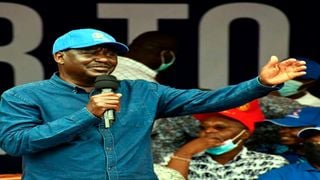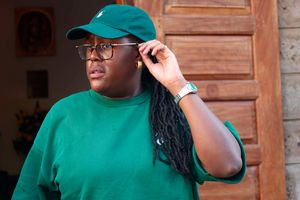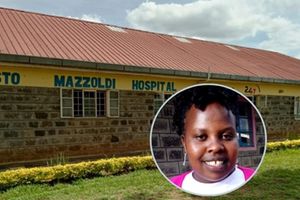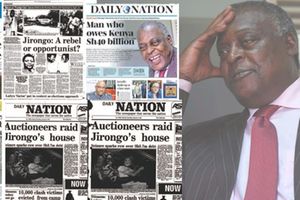
ODM leader Raila Odinga. There is anxiety in the top ranks of the Orange party ahead of the planned registration of the Azimio La Umoja Movement as a coalition party.
| File | Nation Media GoupPolitics
Premium
Kibaki ghosts return to haunt Raila’s Azimio La Umoja poll plan
There is anxiety in the top ranks of the Orange Democratic Movement (ODM) ahead of the planned registration of the Azimio La Umoja Movement as a coalition party.
ODM honchos are afraid the party could lose its parliamentary strength to the Azimio La Umoja affiliates and fall into the “Kibaki syndrome”.
The fear stems from a proposal to use zoning as a formula that will require ODM not to field candidates in the coalition members’ strongholds.
That inevitably means fewer ODM members getting elected to Parliament.
Parties in the Azimio coalition, including Jubilee, Party of National Unity (PNU) and the United Democratic Movement (UDM) have agreed to support ODM leader Raila Odinga’s State House bid.
However, the zoning proposal may diminish the number of lawmakers loyal to Mr Odinga since coalition partners’ first allegiance is to their party leaders.
Consensus
To forestall this possibility, a proposal to settle on Azimio candidates by consensus has been tabled but some parties have rejected it.
In the 2007 General Election that led to violence on account of a disputed tally, President Mwai Kibaki’s PNU won 43 seats in the National Assembly compared to Mr Odinga’s 99 ODM lawmakers.
ODM had its way in Parliament by the virtue of its superior numbers, which saw it dominate the legislative agenda for the better part of Mr Kibaki’s second and final term in office, including at the election of Mr Kenneth Marende as Speaker.
In the end, Mr Kibaki had to lure Wiper Party – then ODM Kenya – and other fringe outfits to his side to be able to govern.
ODM-K leader, Kalonzo Musyoka, became the Vice President but the post-election stalemate also saw the formation of a coalition government, with Mr Odinga being named the Prime Minister.
Insiders say the idea in the proposed Azimio coalition is to have every party know what it is getting before the elections.
Mr Odinga will be bound by the coalition agreement should he emerge victorious on August 9.
The proposed agreement is also intended to shield the president from blackmail by coalition partners.
Some of Mr Odinga’s allies say reduced ODM strength in the National Assembly and Senate is a less price to pay if that is what it would take to get him to State House.
“A president is so powerful a figure and office that you don’t need to worry about numbers in Parliament,” an ally of Mr Odinga, who declined to be named, told the Sunday Nation.
Even more worrying for ODM is the fact that in the event of a win, it would have to contend with a feisty United Democratic Alliance (UDA)/Kenya Kwanza alliance steered by Deputy President William Ruto in Parliament.
Dr Ruto is said to be working on a strategy he hopes will see him win the presidency and a majority seats in the bicameral Parliament.
Simmering differences
According to pundits and some ODM politicians, focus on the presidency is slowly making the party and its leaders lose sight of the simmering differences and competition being posed by other outfits in the lower seats.
During a recent Azimio La Umoja rally in Siaya County, it even appeared that some party supporters had forgotten the ODM slogan.
Mr Odinga comes from Bondo in Siaya.
When Rarieda MP Otiende Amolo rose to speak, he chanted “ODM”, expecting the crowd would respond with the “Mbele Pamoja” slogan, but all the lawmaker got were murmurs.
“Bwana Junet, ni kama hawa watu ni kama wanasahau maneno yetu ya chama, (Junet it appears our supporters are forgetting our party matters),” Dr Amolo said.
He was addressing Suba East MP and ODM Elections Director Junet Mohamed.
There are also concerns about the new Azimio brand of Royal blue colour as opposed to the usual orange that used to stamp some form of authority across the board.
The dominant colour in recent rallies has been blue, which is yet to click in many supporters, especially in the rural Kenya.
Shadow of former self
ODM Director of Political Affairs, James Opiyo Wandayi, downplayed the concerns, arguing that the party is in the process of building a coalition.
Mr Wandayi added that the colours of the new alliance would be known soon.
“The ultimate shape, form and character the party and coalition will take will be apparent in the fullness of time,” he said.
The Ugunja MP added that the party leaders are not just focusing on the two Houses of Parliament and county assemblies but also on dominating the Council of Governors.
“We will field the most popular candidate under the Azimio framework. We have put everything in order after learning lessons,” Mr Wandayi said.
From the 99 seats won in 2007, the number of ODM lawmakers in the National Assembly has been reducing in subsequent elections.
In 2013, the party secured 78 constituency seats and 14 Woman Representatives.
The 2010 Constitution increased the number of constituencies from 210 to 290.
In 2017, some 62 MPs were elected on an ODM ticket and 11 Woman Representatives.
Out of the 40 Nyanza constituencies, ODM took 23 in 2017.
The remaining 17 were distributed among the other National Super Alliance (Nasa) coalition parties.
It should, however, be known that no party has maintained or increased its numbers significantly in subsequent elections since the first multi-party elections in 1992.
Kanu, the independence party, is a shadow of its former self.
Jubilee, with its super numbers in 2017, is limping to the finish line.
The party even lost in recent by-elections seats it won in 2017.
Red flag
Former Rarieda MP, Nicholas Gumbo, told the Nation that the reducing number of ODM elected leaders should worry the party.
“That is a red flag. ODM leaders should ask themselves why people are opting for less volatile parties or running as independent candidates,” he said.
Mr Gumbo, who ran as an independent and lost to Cornel Rasanga in the 2017 Siaya governor race, said despite changes in the party structures, the same names keep cropping up.
He said messaging, party primaries and dependence on euphoria or crowds are some of the problems that work against ODM.
Some ODM lawmakers opposed nominations through consensus have signalled plans to defect to Azimio la Umoja Movement affiliate parties.
DAP-K
Ms Naomi Shiyonga, a nominated ODM Senator, has shifted to the Democratic Action Party of Kenya (DAP-K), citing lack of democracy in Mr Odinga’s outfit.
“Even though I was nominated on an ODM ticket, I will be vying for the Woman Representative seat on DAP-K ticket because we want an even playing ground in Azimio,” Ms Shiyonga said.
“Affiliate Azimio parties should be allowed to field candidates for all elective seats. Our common interest is making Mr Odinga the fifth president of Kenya.”
DAP-K, whose stronghold is Western Kenya, does not agree with ODM on nominations and fielding of candidates.
Whereas the DAP-K leadership is insisting on fielding candidates in all elective seats except the presidency, ODM is insisting on consensus.
While opening offices in Butere, Matungu and Lugari constituencies in Kakamega County recently, DAP-K leader Wafula Wamunyinyi said the party would field candidates for Ward Representative, MP, Governor, Senator and Woman Representative.
“We are solidly behind Raila Odinga, the Azimio presidential candidate,” Mr Wamunyinyi said.
“We want to have healthy competition in Azimio La Umoja. May the strongest candidates carry the day.”
Though Mr Wamunyinyi wants Azimio affiliate parties given freedom to field candidates in other elective seats, ODM has made it clear that it would not entertain competition from its siblings in the coalition.
Kakamega Governor, Wycliffe Oparanya, is pushing for consensus in nominating candidates.
Additional reporting by Shaban Makokha






